Considered one of the most beautiful freshwater fish, Cichlids are usually an aggressive fish breed. They don’t go very well in community tanks as they try to be predators or bully other fish. This typical behavior puts other fish in your community tank at risk. That’s why you need to select non-aggressive cichlids for a community aquarium.
With some research and careful planning, you can find some species that go well with your cichlids. Below are some friendly Non Aggressive Cichlids who live peacefully in a tank.

8 Types of Non-Aggressive Cichlids for Community Tank
Jump To
- 1 8 Types of Non-Aggressive Cichlids for Community Tank
- 2 Why cichlids become aggressive?
- 3 How to Minimize Aggression in your Aquarium
- 4 What are the least aggressive African cichlids?
- 5 Best Cichlid tank mates
- 6 Do cichlids kill each other?
- 7 Are Duboisi cichlids aggressive?
- 8 Can bettas live with cichlids?
- 9 Summary
Blue Acara (Aequidens pulcher)
Blue Acara is a beautiful blue-colored cichlid that is non-aggressive. They tend to dig in the sand and prefer warmer water between 75°F and 80°F. Blue Acara is the right choice for cichlid novices as they can digest many types of food and are very hardy.
| Size | 15 cm |
| Origin | Tropical America |
| Care level | Easy |
| Temperament | Peaceful, non-aggressive |
| Water condition | Temperature 72° to 82° Fahrenheit, ph level 6.0 to 7.5 Water hardness 6 to 20 dH |
| Compatibility/tank mates | Lives peacefully with any similar-sized fish |
| Tank Setup | Minimum 30 gallons, Soft sandy surface with floating plants |
| Feeding | An omnivore species, bloodworms, daphnia, mosquito larvae, and brine shrimp and flakes and pellets |
| Life span | 8 to 10 years in captivity |
| How many blue acara can go in a 20 -gallon tank | 2 |
| Special tips | Avoid mixing them with smaller fish and overly aggressive fish |
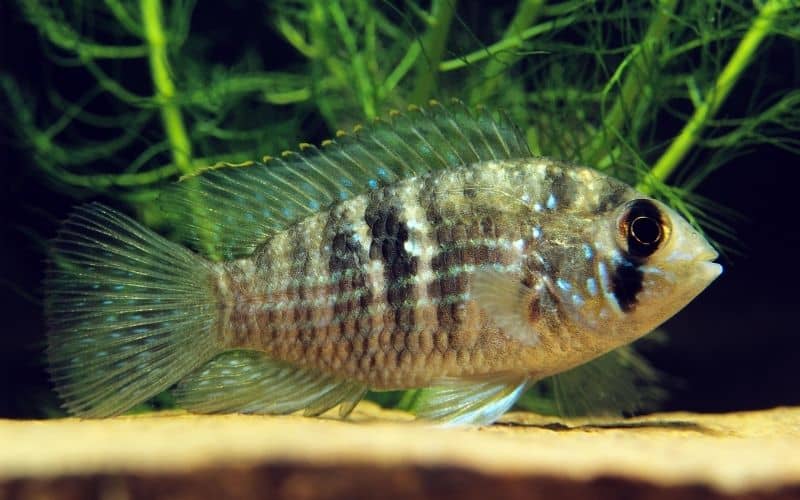
Agassiz’s Dwarf Cichlid (Apistogramma agassizii)
Agassiz’s Dwarf Cichlid is a carnivorous fish that tend to see small fish as prey. They prefer to live in open areas with plants and fit in community tanks that have larger fish.
Size : 6cm
Origin: South America
Care level: Intermediate
Temperament: peaceful
Water condition : temperature 73.0 to 81.0° F (22.8 to 27.2° C), ph range 5.0-7.0, hardness 2 – 10 dGH
Compatibility/ tank mates: can be kept with a mix of various tropical fish that are not aggressive
Tank Setup: minimum 20 gallon
Feeding: newly hatched baby brine, frozen brine shrimp, crustaceans, insects, insect larvae, flakes, and pelleted foods
Life span: 5 years
How many Agassiz’s Dwarf Cichlid can go in a 20 gallon tank? : 2
Special tips: Include lots of plants into the aquarium, avoid smaller fish.
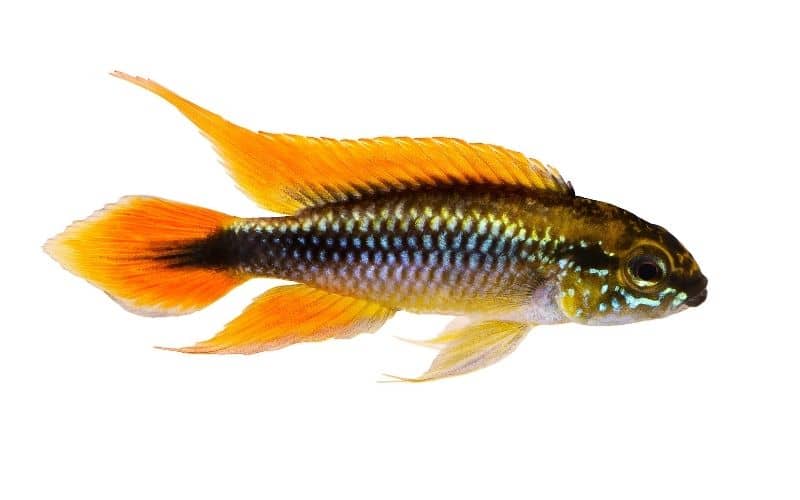
German Blue Ram (Mikrogeophagus ramirezi)
These 2 inches long dwarf cichlids are non-aggressive cichlid which can live among non-aggressive tank mates. However, they are a territorial species when they live in pairs. The tank should be large enough for them to establish their territory, and they can eat many different carnivore foods.
Size : 5cm
Origin: Rio Orinoco drainage basin of the llanos, a vast savannah spanning the lowlands of both Venezuela and Colombia
Care level: advanced
Temperament: peaceful
Water condition: ph 5-6, temperature 80° to 86°F (27° to 30°C)
Compatibility/tank mates: Any small fish that are non-aggressive
Tank Setup: 10 gallons minimum
Feeding: flakes, meaty live and frozen foods such as bloodworms, brine shrimp, and daphnia
Life span: 2-4 years
How many German Blue Ram can go in a 20 gallon tank? : 2 to 4
Special tips: susceptible to water quality, include plants and round rocks to the tank.
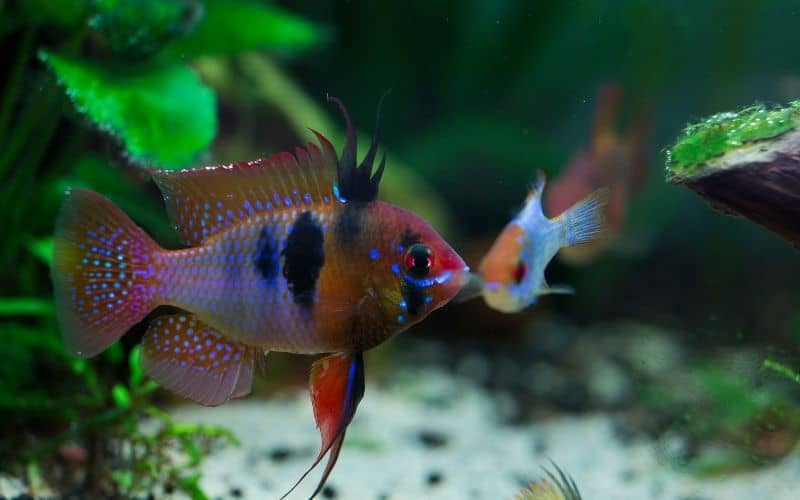
Masked Julie (Julidochromis transcriptus)
Masked Julie is a small fish growing to only 7cm, endemic to Tanganyika. They prefer living in tanks decorated with rocks. They can fit into a tank if their requirements for tank parameters are met.
Size : 7cm
Origin: Africa
Care level: easy
Temperament: semi-aggressive
Water condition : pH range: 8.5 – 9.2, dH range: 8 – 14, Temperature 22°C – 25°C
Compatibility/tank mates: can be kept in a community with other similar-sized Tanganyika cichlids
Tank Setup: 20 gallon
Feeding: omnivore, flakes, pellets, meats, and some vegetables
Life span: 5 years
How many Masked Julie can go in a 2o gallon tank? : 2-3
Special tips: avoid overfeeding and overstocking
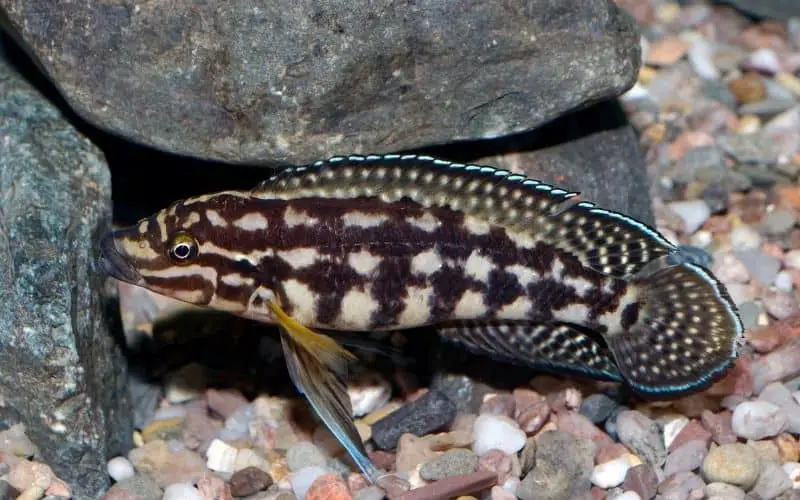
Read more Top 10 Dwarf Gourami Diseases | Identification | Treatment
Severums (Heros serverus)
Severems are one of the largest cichlid species in the world growing up to 10 inches long. Severum is an omnivorous fish that will eat smaller fish in the tank. They don’t typically attack other fish so they can be kept with an extensive range of medium-sized fish species, including small tetras and Oscars.
Size: 20-25cm, 30cm maximum
Origin: South America
Care level: intermediate
Temperament: semi-aggressive
Water condition: Temperature: 22-29° (72-84°F), pH: 5.5-7.0, Hardness: 1-8°H
Compatibility/tank mates: compatible with large, peaceful species
Tank Setup: 45 gallons minimum
Feeding: omnivorous, bloodworm, chopped earthworms, and prawns, some vegetables, pellets, and flakes
Life span: 10 years
How many Severums can go in a 20 gallon tank? :2-3
Special tips: provide a sandy surface with low lighting
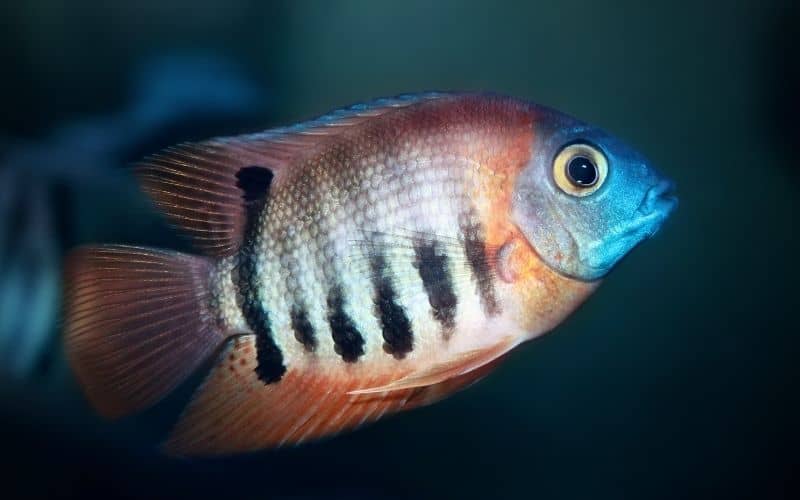
Rainbow Cichlid (Herotilapia multispinosa)
This rainbow-colored cichlid is one of the easiest fish to keep and breed. It grows up to 5 inches long and lives well with small tankmates. Although this is an omnivorous species, it’s non-aggressive by nature. They can be bred well in captivity and accept a variety of tank environments.
Size : 17cm
Origin: Central America
Care level: easy
Temperament: peaceful
Water condition: Ph range 5-7, Dh range 9-20, temperature 21°C – 36°C
Compatibility/tank mates: can be kept in a tropical tank with catfish, specific livebearers, tetras, giant danios, rainbows, and plecostomus
Tank Setup: 20 gallons minimum
Feeding: pellets, frozen and live foods, and some vegetables
Life span: 7-9 years
How many Rainbow Cichlid can go in a 20 gallon tank? : 4
Special tips: sand substrate, moderate water flow, and low lighting is recommended
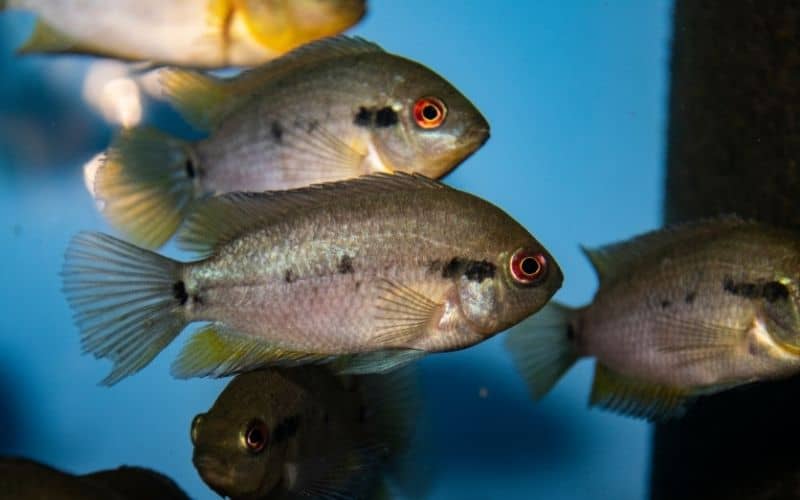
Keyhole Cichlid (Cleithracara maronii)
This 4 to 5 inches long fish is one of the most non-aggressive cichlids you can find. They are very peaceful and very shy. Keyhole cichlid needs lots of hiding places in the tank. They fit in any community tank as they are peaceful and will always back down from a fight.
Size : 7cm
Origin: Guyana, Suriname, the Orinoco delta region in Venezuela, and the island of Trinidad
Care level: intermediate
Temperament: peaceful
Water condition: Ph level 4- 7.5, hardiness 36 – 268 ppm, temperature 21 – 28 °C
Compatibility/ tank mates: can be kept with all larger sizes of non-aggressive fish. Keyhole cichlids eat smaller fish.
Tank Setup: 20-gallon minimum
Feeding: omnivore, pellets, flakes, frozen and live meats
Life span: 6-8 years
How many Keyhole Cichlid can go in a 20 gallon tank? : 2
Special tips: Add a soft sand substrate with a plethora of hiding places
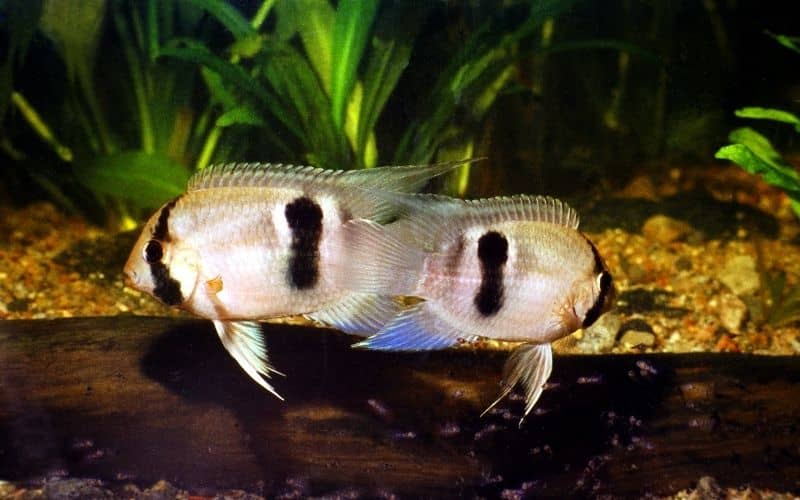
Angelfish (Pterophyllum scalare)
One of the most popular cichlids of the world is called “Angelfish” among aquarists. This fish is available in all sorts of beautiful colors and patterns.
They can be kept with some other fish types, which are NOT nippy, extraordinarily active, or too small.
Size : 15cm maximum
Origin: the Amazon Basin in Peru, Colombia, and Brazil
Care level: Intermediate
Temperament: Lives well with calm tank mates but eats small fish
Water condition: Requires 40+ gallons, pH of 6.0 to 7.0, a water hardness range
3 to 10 °dH, water temperature 26 to 30 °C (75 to 86 °F)
Compatibility/tank mates: Non-aggressive with any larger calm fish
Tank Setup: Amazone biotope tank with plenty of leaf litter and wood
Feeding: juvenile fishes, prawns, mosquito larvae, and worms
Life span: 7 to 10 years
How many (Angelfish) can go in a 20-gallon tank? : 4 to 6
Special tips: Need tropical climate and freshwater
Aquarium gear :
Why cichlids become aggressive?
Unlike humans, fish usually have complex social behavior. Aggression is one of them. A fish can be aggressive towards other fish because of breeding, being the alpha, and finding more food than others.
Territorial behavior
For example, African cichlids become aggressive to secure their territory. They want to show other fish that they are the alpha and have the most strength; hence bully others and be territorial.
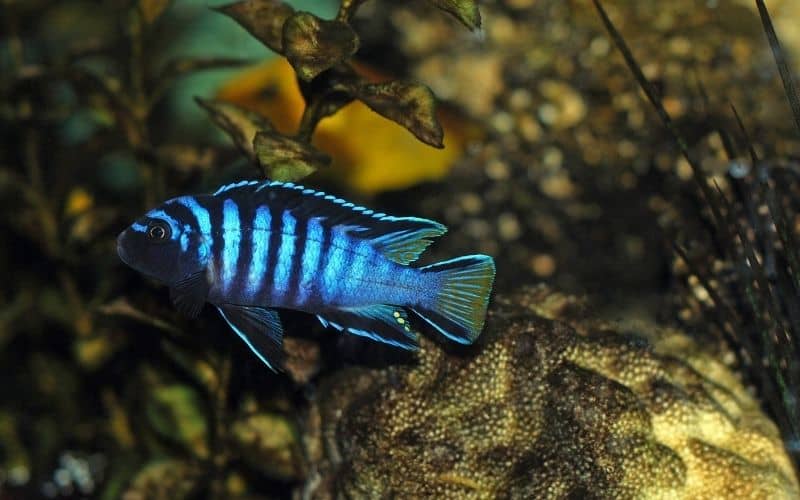
Breeding aggression
Cichlids also become aggressive when breeding. Their testosterone level goes so high that they try to toss everyone else to breed with the female.
Food availability
If they get lesser food in the tank, they tend to become aggressive to secure their food source. Keeping these things in mind, we can offer a suitable environment for cichlids to live in a community tank. For example, keeping a larger fish tank and feeding them properly.
How to Minimize Aggression in your Aquarium
The first thing you should do is keep a fish tank that is big enough for all the fish you put.
Minimum 55-Gallon tank size can reduce the cichlid aggression toward other fish. With more water, they receive more space to secure their territory. And they tend to become peaceful if they have enough territory to protect.
Even though you have a giant fish tank, you may find your fish to become aggressive if you put more fish in your community tank.
So, keeping the population at a minimum is vital for cichlids to live peacefully.
Breeding is a natural behavior of cichlids. They become aggressive when finding a mate who can live outside their territory. Polygomos cichlids try to mate with females within the aquarium, while monogamous males focus on a single female. Depending on the fish type, you can keep them in a separate tank while breeding to ensure other fish’s safety in the community tank.
Also, plenty of hiding places are key.
What are the least aggressive African cichlids?
African cichlids are known to be more territorial and aggressive than South American cichlids. While aquarium hobbyists find that African cichlids are hard to mix up with community tanks, some African cichlids are the least aggressive.
Electric Yellow Lab, Yellow Tail Acei, Sulfur Head Peacock, Blue Orchid Peacock, and Blue Orchid Peacock living in Lake Malawi are known to be the least aggressive they can be put together with other fish in a community fish tank.
Best Cichlid tank mates
Murray River Rainbowfish
Many rainbow fish can coexist with cichlid fish. Species like the Australian rainbow can live with aggressive African cichlids. But other rainbowfish are better kept with non-aggressive cichlids varieties.
Red-eyed tetra
As same as rainbow fish, many tetras can live with cichlid fish. But only a few tetra species like Red-eyed tetra can live with aggressive cichlid varieties. Red-eyed tetra is a big fish compared to other tetras. Therefore cichlids do not usually attack them.
Giant Danios
Their beautiful body color is definitely a valuable attraction to your aquarium. Due to their large body size and active nature, cichlids do not try to attach them.
Bottom feeders
Apart from the above fish species, bottom-feeding fishes like Synodontis multis (Cuckoo squeaker catfish), Synodontis petricola (Pygmy leopard catfish), Bristlenose pleco, Clown pleco, Clown loach can easily be kept with cichlid species.
Do cichlids kill each other?
For example, the most aggressive cichlids, M. chipokae and M. auratus can actually kill each other while in the battle of establishing their territory. When something like this happens, keep in mind to keep the aggressive fish in a separate tank or give it away.
Are Duboisi cichlids aggressive?
A beautiful cichlid species entirely black with white spots is an African cichlid that tends to be more aggressive. This fish is extremely aggressive toward their kind and should be housed in large groups of 6 or more.
This very personable fish needs an aquarium of at least 50 gallons and should be kept with a large number of the same species. ‘Larger the number, lesser aggressiveness’ is valid for Duboisi cichlids.
Can bettas live with cichlids?
You can not put betta and a cichlid in one tank. Cichlid will identify betta as a treat and attack the fish. This misidentification is mostly due to the long-tail fin of betta fish.
Cichlid mostly tries to tear-up betta’s long tail fin. Betta fish can not swim properly if their fin is damaged. other than that damaged fin can lead to several types of disease conditions in betta fish. So keep in mind not to keep cichlid and betta fish in the same tank.
Summary
Cichlids are colorful species that can be found all over the world. There are at least 850 known species, while most species are aggressive toward other fish. Some cichlids are proven to be non-aggressive over some fish species. If you want to build an aquarium with many fish species, including cichlids, you should choose non-aggressive cichlids. Otherwise, they will end up killing one another.
Above are eight types of non-aggressive cichlids you can put in community tanks. And who doesn’t like colorful fishes in their tank? I know I do. Your perfectly optimized content goes here!
Read more Can I Keep Koi and Goldfish In the Same Tank? All To Know
